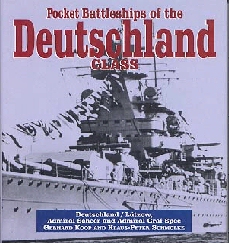|
|
| Tell me when this page is updated |
|
|
| Tell me when this page is updated |
|
|
Pocket Battleships of the Deutschland Class: Deutschland/Lützow, Admiral Scheer, and Admiral Graf Spee by Gerhard Koop and Klaus-Peter Schmolke [trans. by Geoffrey Brooks], Greenhill Books, London, England and Naval Institute Press, US Naval Institute, Annapolis, Maryland USA, 2000 Review by Peter K. H. Mispelkamp
 This title represents the third installment on the authors' series on the major classes of warships that served in the German Kriegsmarine. Like its predecessors, this 224 page book is divided into three distinct sections, which are buttressed by a brief forward and conclusion, a bibliography and an index of ship names, however there are no appendices in this volume. Once again, the authors have managed to gather an outstanding collection of detail and "glamour" photographs that should appeal to most of its intended audience, but it still lacks a table of photographs. The first section is devoted to a general design history of these ships, which encompasses German warship design before and during the First World War, the Treaty of Versailles (1919), the Washington Naval Agreement (1922) - to which Germany was not invited - and Hitler's rise to power (1933). In essence, the authors have managed to portray all of the elements that lead to the construction of these then revolutionary warships. They correctly note that the Treaty of Versailles did not limit the caliber of the main armament of future German warships larger than cruisers, and that the then Reichsmarine classified these ships as "Panzerschiffe" or "armoured ships" in deference to the terms of the peace treaty. They also mention the domestic political turmoil that resulted from the Weimar Republic's decision to build these ships as well as the international repercussions. Unfortunately, the authors do not discuss the claim advanced by other writers that the former World War I Allies secretly approached Germany to abandon the construction of these ships because they threatened to upset the warship type specifications as determined in the Washington Naval Agreement. In any case, since these ships were designed within the parameters of the Treaty of Versailles, the former Allies could not prevent their construction. While they were not battleships or even battlecruisers, they were deemed capable of outrunning all but a few capital ships then in existence, and were believed to be powerful enough to outgun any "Washington" type cruiser. In its own small way, their construction signaled that Germany's former adversaries were beginning to relax their vigilance over German re-armament. In 1920, the Disarmament Commission had vetoed the original design of the light cruiser Emden which featured twin 150mm turrets, but by 1926 they could not prevent the construction of Germany's radical panzershiffe. The second section presents a more technical history of the ships, and features some excellent illustrations of their equipment and detailed side views of the ships in their various configurations. The latter, in particular, would have greatly enhanced the value of their earlier works on the Bismarck's and Scharnhorst's. Strangely, this feature was not included in their most recent work on the Admiral Hipper class. Also present, is a fine collection of camouflage schemes that depict most of the disruptive patterns ever carried by these ships. Unfortunately, these illustrations are only general in nature, mostly because they are presented in black & white, with limited notes on the actual colors used. Unfortunately, the camouflage pattern attributed to the Graf Spee when she carried a dummy funnel and super-imposed wooded forward turret - with its darkened fore and aft hull sections appears to be a little questionable - especially when one examines the photograph of her in this guise on pages 204 and 205. The third section details the history of all three ships in concise, but still useful, individual accounts. Since their careers were so varied and rarely inter-connected, this approach is acceptable. Like the other two sections, readers will be treated to many fine photographs of these ships and garner a better insight into their successes and failures. The authors do exhibit a tendency to quote often from the ships logs and officer reports, but these passages are relatively brief and not really annoying. Again, the translation is a little "off" in some passages but this does not affect the overall flow of the volume. The conclusion is very useful, and should be read by anyone who wants a better insight into the military, political and economic decisions that effect warship design, and the relative merits of these ships in particular. Anyone who believes that they represent the best-designed ships in Hitler's Kriegsmarine will be well served by reading their conclusion. Overall, this is probably the best volume in the series, and very worthy of consideration as the best reference on this class of very unique warships.
Return to Book Reviews |